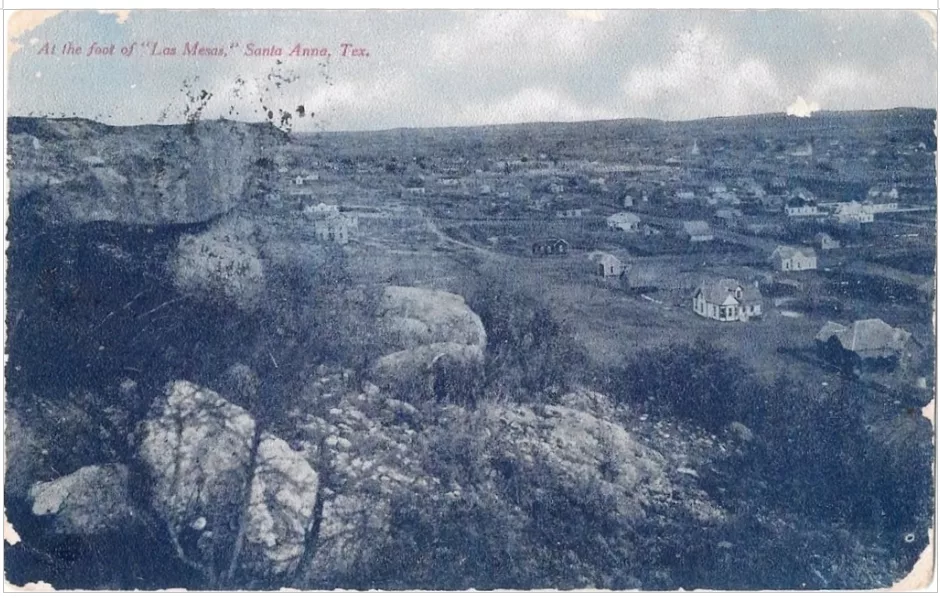
When my son was younger, he roamed with a pack of neighborhood boys in the summer, looking for things to do. The kids had an idea to build a treehouse part of the way up Santa Anna Mountain. They didn’t get very far with the project. Heat, thorns and the sheer scope of the endeavor eventually defeated the plan, but in the course of digging around for things they could use to build this fort, my son found a strange looking rock and brought it home. It’s a round, very heavy, black rock with a lighter colored material inside. My first thought when I saw it was that it might be a meteorite.I researched it, and still don’t know if it is one, but I came across some stories about a meteorite the Comanche had found up on the mountain. This meteorite was a prized possession of the tribe, and was a central feature for their religious practices.
There is a magic about holding something in your hand that came from outside our world. Since the beginning of recorded history, people have sought out and treasured meteorites, believing they held supernatural qualities. It was thought that the possessor of a meteorite could travel more easily into the spiritual realms, and could also perform acts of healing and conquest.
The story of the Santa Anna meteorite, known today as the Wichita meteorite, is documented in detail by anthropologist and Penatuhkah Comanche history expert Linda Pelon, in her book, Texas Comanche Land Revisited. According to Pelon’s research, based on writings by Emmer Harston, the Comanche told the story of a ‘fire rock’ which landed on top of the East end of Santa Anna Mountain at ‘High Point’. The rock, or a portion of it, was kept in a hidden cave formed in a cliff face on the mountain, only accessible by a rope ladder.
“It was on this High Point that the ‘firerock’ fell, and it was here the ‘eternal fires’ were kept burning. Here also was the center of ‘fire and smoke communications’,” Pelon writes..”The fire rock, which tradition said was sent them by the Sun, was given an honored position in the secret chamber. Civil Chief Mope Chocope informed Dr. J.J. Sturm and the author that ‘the fire rock was kept there for 100 years–until the cavern began to cave in.”
Pelon records that the cave which held the revered meteorite collapsed around 1805. The Comanche women dug into the hillside to reach the lost relic, and successfully retrieved it. Pelon believes the heavy rock was dragged by a slow and arduous process, spanning two years to complete, and that it may have ended up near a Comanche training camp along the Red River. The meteorite was placed in an ‘upright position, atop a ledge of rock.’ It was found by Texas state legislator and Indian agent Robert Neighbors, who brought it to San Antonio in July 1836. Neighbors described the ‘Medicine Rock’ as “a beautiful specimene” and wrote that the Comanche made offerings to it and rubbed themselves against it to receive healing.
Called the Wichita meteorite and also ‘Comanche firestone’ the 223 pound rock is now displayed at the Texas Science & Natural History Museum in Austin. So it is probably not on my kitchen window ledge, where I keep the odd rock my son brought down off the mountain. I never have followed through all the way with getting the rock tested to see if it really is a meteorite, I guess partly because I like to believe that it is one.
Imagine the tremendous burst of fiery green light that must have lit up this mountain several centuries ago. A rain of heavy, metallic rock bursting down onto the hill, terrifying the people below, who might well have thought the world was ending. In our day of materialist thinking, no one would believe that a meteorite could have any healing powers or the ability to take you on a trip to other worlds, except, perhaps, for eccentrics like myself.
***
Diane Adams is a local journalist whose columns appear Thursdays on BrownwoodNews.com. Comments regarding her columns can be emailed to [email protected].
